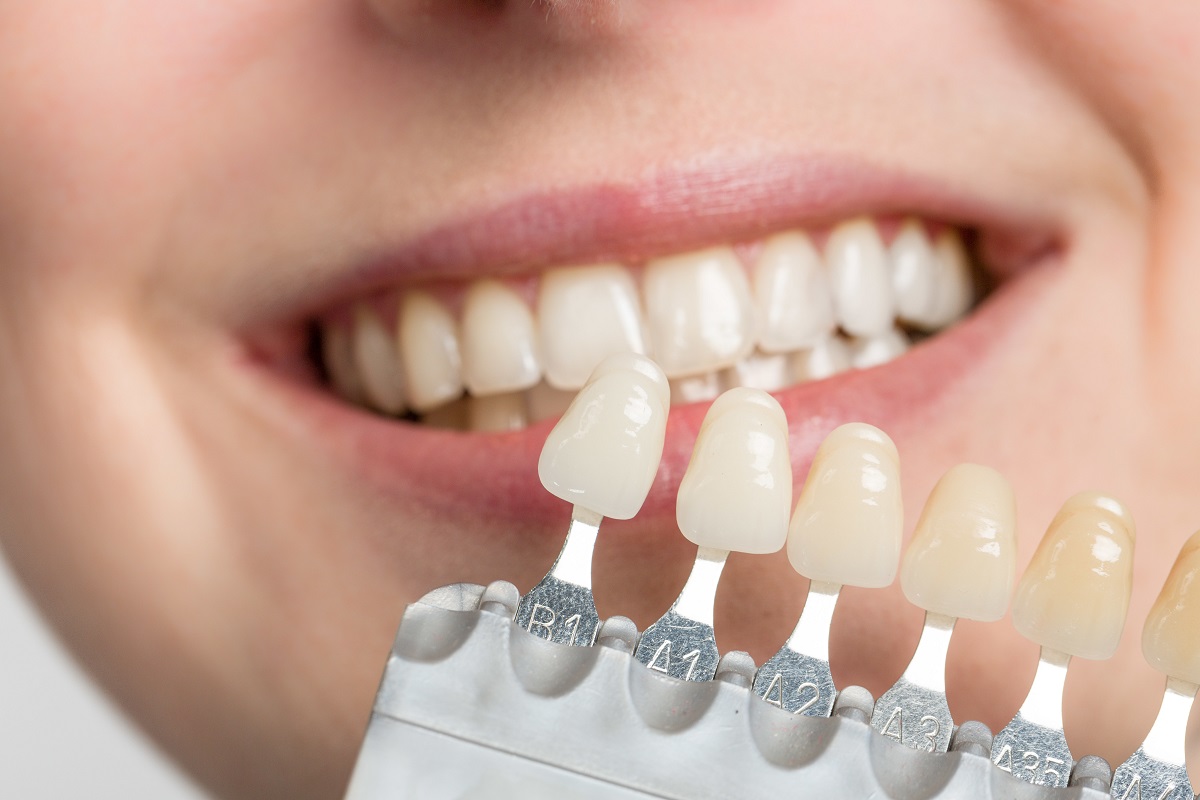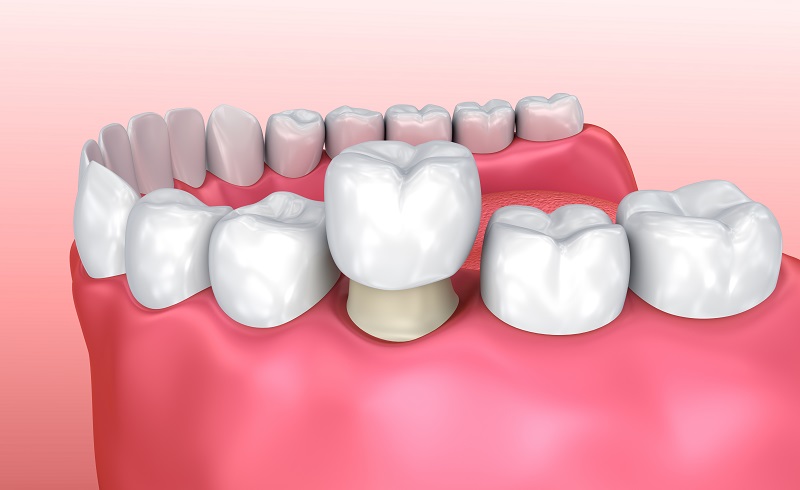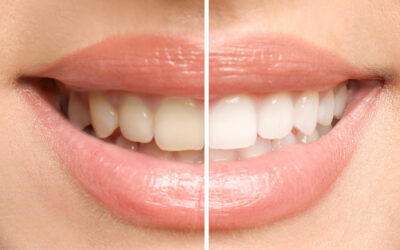Crowns and veneers are dental restorative options that can help your teeth look and function better. While veneers and crowns are different procedures, they both boast great success rates.
Since dental restoration procedures can be costly, we feel it is important for our patients to have a thorough understanding of each procedure.
What Are the Main Differences?
- Veneers consist of a very thin layer of porcelain that gets bonded to the front of an existing tooth. They are between 0.5 and 1mm in thickness.
- Crowns cover an entire tooth and are roughly 2mm thick. Crowns can be all porcelain, an all-metal alloy (such as gold), or a fusion of porcelain and metal alloy (PFM).
Both veneers and crowns are colour-matched to a patient’s teeth, except for all-metal crowns.
Whether a veneer or a crown is appropriate for you will depend on the condition of your teeth and what you hope to fix. Common conditions for restoration are:
- Decayed or weakened teeth
- Discoloured teeth
- Chipped, cracked, or broken teeth
- Crooked teeth
What Is A Veneer?
Veneers only cover the front surface of a tooth. Since the preparation leaves more of the original tooth intact, veneers are not as invasive as crowns.
To prep for a veneer, roughly a half a millimetre of a tooth’s enamel is removed to create enough space for the dental technician to create a natural-looking and strong veneer.
These days due to improving material technology veneers do not require as much grinding of the tooth’s surface and sometimes don’t need any drilling at all. A local anaesthetic may be used to ensure the patient is as comfortable as possible during the procedure.
Veneers need an adequate amount of enamel to bond to in order to be successful.
What Does the Process of Getting a Veneer Involve?
Planning is everything when it comes to aesthetic dentistry. Typically we will take photos and a digital scan of a patient’s existing teeth and begin to design the ideal smile for each patient. This includes, size, shape and shade of the teeth as well as factoring in any characteristics that make a patient’s existing smile their own.
Once, in combination with our dental laboratory, we have designed the perfect smile we will show the patient the result and do a “mockup” in their mouth. This involves temporarily placing the designed smile onto our patient’s current teeth to “trial” their new smile on a temporary basis.
Assuming we are happy we will then proceed with the procedure. Once we have prepared the teeth for veneers we will take an impression of the teeth or use a digital scanner. The mold or image is then sent out to a lab for fabrication.
If a significant amount of the teeth were trimmed, temporary veneers may be placed over it until the permanent veneers are ready.
Once ready, the permanent veneers are bonded to the teeth using special bonding cement. It is then hardened using ultraviolet light.
Generally, there is minimal movement of the tooth once the veneers are placed. However, a nightguard may be recommended to protect the veneers if you clench or grind your teeth at night.
 What Is A Crown?
What Is A Crown?
Crowns cover the entire tooth and require more of the tooth to be ground down or filed in preparation for the crown placement.
If a patient has tooth decay, the decayed portion will be removed prior to making the crown. In some cases of decay or damage, the tooth may need to be built up in order to accommodate the crown. A local anaesthetic is always used for the procedure to ensure our patients have a completely pain free experience.
What Does the Process of Getting a Crown Involve?
To begin, an impression of the tooth is taken that we use to make a temporary crown at the end of the appointment. The tooth is then reduced by approximately 1mm on all sides of the tooth to create enough room for the porcelain crown. Once this is completed a digital scan is taken of the tooth and sent to the laboratory to begin manufacture of the new crown.
A temporary crown is then placed over the tooth until the permanent crown is made. Once the permanent crown is ready, the temporary crown is replaced. The permanent crown is then adjusted to fit properly and ensure a correct bite. Once the fit is approved, the crown is cemented into place.
How Do You Know If A Veneer Or Crown Is Better For You?
If the tooth is significantly cracked, very worn, or has a large filling or a root canal, a crown may be the best option.
If the tooth is generally intact and the restoration is more for cosmetic reasons, a veneer may be recommended. Veneers can also be an option for addressing minor shape corrections.
 How Much Do Veneers And Crowns Cost?
How Much Do Veneers And Crowns Cost?
Veneers and crowns costs can vary. The cost typically depends on the type of material being used but range from $1000 to $1650.
If you have major dental cover on your health insurance then unto 90% of this can be covered (please check with your insurer as individual policies and rebates vary.)
Veneers
The cost of a porcelain veneer starts at $1000. Although more expensive than composite veneers, porcelain veneers last longer and have better aesthetics.
Crowns
The cost of a crown is based on the size of the tooth, the amount of preparation required, and the material used to create the crown but start from $1400
The total cost may not reflect additional procedures such as root canals or core buildup that may be necessary before the crown is made.
In general, ceramic and porcelain crowns are slightly pricier than all-metal crowns.
Pros and Cons of Veneers and Crowns
Both veneers and crowns have advantages and disadvantages. When considering these different procedures, it is important to be aware of the pros and cons they each offer.
Veneer Pros
- In some cases, veneers require minimal trimming, leaving the majority of the healthy tooth in tact.
- In the long run, veneers can be more aesthetically pleasing, since they do not show gum margins after several years as some crowns do.
Veneer Cons
- Veneers are not reversible.
- Veneers leave more areas of the tooth exposed and susceptible to new decay.
- Composite veneers cost less, but may only have a lifespan of 5 to 7 years. Other materials last longer, but may have to be replaced.
Crown Pros
- Crowns are relatively permanent and do not require removal before cleaning as dentures do.
- Some dental insurance companies may cover a portion of the cost of a crown.
- With the entire tooth covered, it is less susceptible to decay.
- Porcelain crowns mimic the look and feel of natural teeth.
Crown Cons
- More of the natural tooth must be removed to accommodate the crown.
- Porcelain fused to a metal alloy (PFM) crowns show a thin, dark line between the natural tooth and the crown.
Are Veneers or Crowns Right For Me?
Before your procedure, it is important to know how much your veneer or crown will cost, and if your insurance company will cover any of the cost. It is also important to research your dentist’s experience with crowns and veneers.
If you have any questions about veneers or crowns and if they would be appropriate for you, please feel free to contact us. We would be happy to set up an appointment for you to determine which option would be best for you.




 What Is A Crown?
What Is A Crown? How Much Do Veneers And Crowns Cost?
How Much Do Veneers And Crowns Cost?


